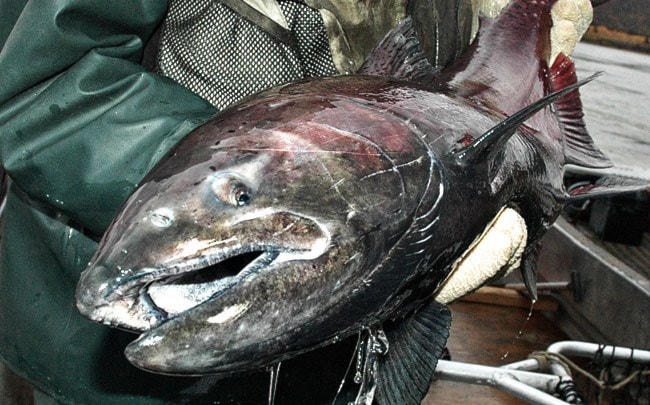Overfishing in Alaska is to blame for the closure of domestic, commercial and recreational chinook salmon fisheries on the Yukon River, says the chair of the Yukon Salmon Committee.
American officials have miscalculated, mismanaged and allowed overfishing this year, causing low salmon runs and severely affecting Yukon fisheries, said Carl Sidney in an interview with the News.
“They’re overfishing at the mouth of the river,” said Sidney, also a fisherman in the Teslin area.
“The Americans know they screwed up the numbers. Bottom line — it’s poor management. They should have had more restrictive closures. I think they miscounted the numbers and thought there’d be more fish coming through.”
Last week, the department of Fisheries and Oceans closed the domestic and commercial chinook salmon fisheries, while recreational fishing is allowed only if anglers release their catches.
This year’s salmon run is estimated at 25,000 to 30,000. Fisheries and Oceans requires an escapement number of 33,000 to 43,000 to keep all fisheries operating.
Salmon run predictions are made at the beginning of the fishing season by a joint technical committee, created by an agreement with Alaska. This is called the Yukon River Salmon Agreement.
“I feel like I’m being bullied into a corner because the fish come through their territory before ours and they take advantage of that,” said Sidney. “By the time the fish get down to my area in Teslin, there’s nothing left to fish.”
According to the Alaskan department of fish and game, 125,000 salmon escaped up river in Alaska and the Yukon, lower than the 150,000 estimate made earlier this summer.
The Alaskan department estimates 40,000 salmon will enter Yukon waters, a number within the escapement goal, but Canada’s Fisheries and Oceans disputes that number.
The incorrect assessments from the Alaskan government have led to overfishing and left little for Yukon fishers, said Sidney.
“Only the aboriginal fishery is open,” said Sidney. That’s not fair to the commercial fishery when you have commercial fishing open in Alaska.
“Our agreements say everybody should have some of the fish. Fifty per cent of whatever comes in the river, the salmon is of Canadian origin. And people in Canada are saying they’re tired of raising the fish so the Americans have it all.”
If overfishing continues, the Yukon fishers should start demanding compensation from their Alaskan counterparts, said Sidney.
“If they want to take advantage of the fishery, and 50 per cent of the fish are raised in Canada, they’re going to have to give us something if they continue taking that much fish,” he said.
Fisheries and Oceans officials have been in contact with their Alaskan counterparts to raise concerns about the low numbers of salmon entering Yukon waters, said area director Frank Quinn.
“The Alaskan government claims they’ve measured conservatively and are aware of the low component of salmon originating in Canada,” said Quinn.
“We’re trying to determine if indeed the numbers were weak and what can be done about it.”
Quinn said the government is “definitely looking at the possibility” of overfishing in Alaskan waters.
Yukon fishers set up voluntary closures to conserve salmon stocks and are given $1.2 million from Alaska for restoration practices, half of which is spent at Canadian discretion, while Canadians fund restoration projects in Alaska.
“We’re just fed up with this whole thing,” said Sidney. “That $1.2 million is supposed to be a compensation package, but the Americans didn’t like us calling it that so we named it a restoration-enhancement package.”
The Yukon River Salmon Agreement was signed in 2002, but Sidney said its success has been spotty at best. There are no provisions for compensation in the agreement.
The Yukon Salmon Committee was set up under the Umbrella Final Agreement to manage salmon and its habitat. The 10 members, consisting of Yukon government and First Nations appointees, make recommendations to governments, but have no decision-making power.
Yukon fishers work hard to preserve salmon stock and have done their part to ensure future generations are able to fish, said Teslin Tlingit Chief Eric Morris.
But that’s not being appreciated elsewhere, he added.
“Anything that happens below us, affects us,” said Morris.
“We have a situation where the commercial fishery has been overfished in areas,” he said.
“As a result of that — I don’t know if you’d call it mismanagement — they’ve done themselves out of their livelihood.
“Not to say that people in the Yukon have done that, but down on the coast on the ocean before they enter the river has been a problem.”
Anglers in the Teslin area participate in “no-fish days,” among other programs, to help preserve the stocks, but “there’s still a lot of work to be done” to keep the numbers up, said Morris.
Many people near Teslin fish for their families.
“Myself, that’s my food,” said Sidney. “We don’t sell it. This is food off our table. At the end of the line down in the Teslin… the final destination, we bear the brunt of this whole thing.”
By the time salmon reach spawning grounds, they’re about ready to die and they’re not as hearty as they were at the beginning of the Yukon River.
“Down in Teslin, it’s not that great a quality by the time they get here, but we’ve been raised on it,” said Sidney.
Sidney said changes are needed to the process of how the salmon runs are predicted.
“I’ve been pretty adamant about including elders in the process to incorporate traditional knowledge in their decision making,” he said.
An education exchange, which would bring Alaskan fishers down to Teslin to survey the salmon stock, would help Americans see the problems of overfishing, suggested Sidney.
“I think people are fed up with bowing down to the Americans,” Sidney said. “The fishers haven’t been making money for the last 10 years or so. Nobody’s making any money on it.”
